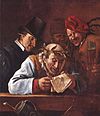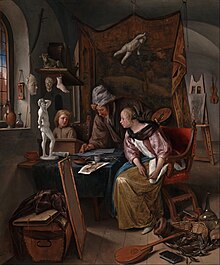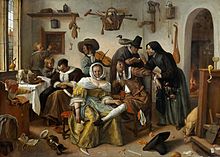Jan Steen

Jan Havickszoon Steen (* around 1626 in Leiden ; buried on February 3, 1679 in Leiden) was a Dutch painter , a master of the Dutch genre painting in the Dutch Golden Age .
Life
Jan Steen was born in 1625/1626 as the son of a brewer in Leiden , he was both a painter and a landlord . He was a pupil of the German painter Nikolaus Knüpfer in Utrecht and Adriaen van Ostade in Haarlem , a painter of rural scenes. He also received his painting training from Dirck Hals . In 1646 he came to the University of Leiden . In 1648 Jan Steen co-founded the Sint Lucas guild of painters in Leiden. On October 3, 1649 he married Margriet ("Grietje"), a daughter of the landscape painter Jan van Goyen . He became his assistant and also moved into his home in The Hague . He worked here until 1653. The following children are known from the marriage: Thadaeus, baptized in the Catholic Church in the Alte Molstraat The Hague on February 6, 1651; Eve, baptized in the same church on December 12, 1653. The dates of birth of Cornelis, Catherine and John are unknown. From 1654 Steen ran the De Roscam brewery in Delft , but without great success. From 1654 to around 1656 he lived in Leiden again. He then lived in Warmond from 1656/1657 to 1660 . From around 1660 to 1669/70 Steen was again active in Haarlem. During this time he was particularly productive. Here he also ran a tavern . His wife died in 1669, his father in 1670. In 1670 or 1673 he married Maria van Egmont, the widow of the neighboring bookseller Herculens, with whom he had two children. From now on Jan Steen lived again in Leiden for the rest of his life. In 1672 he was given permission to run a tavern in Leiden. In 1674 Jan Steen became president of the Sint Lucas guild. He was buried on February 3, 1679 in the family's grave in the Pieterskerk in Leiden.
Steen's imagery
Steen was known for his ambiguous pictorial content. By reinforcing the narrative element and devoting himself to the expressiveness of the characters, the backdrop merely formed the framework to reinforce a mood without dominating it. The exaggerated representation of individual characters creates the impression of a play. Due to the short training period, some shortcomings can be seen in the artist's hand. Errors in perspective and incorrect spatial relationships are compensated for by the abundance of his figures in the picture. This becomes particularly clear in scenes in the interior. The work The Inverted World (1663) shows some deficiencies in the perspective foreshortening of the space. The staggering of the figures and objects suggests a certain depth of the space. Steen thus uses the figures to give the room a three-dimensionality. The group structure often forms a rural tavern scene , as in the work Wirtshausgarten (1661–63), an overcrowded classroom, like the work Die Dorfschule (1663/65), or a household, as in Die verkehrte Welt (1663).
Composition in Steen's late works
The emphasis on the figures increased in Steen's last creative period. The composition becomes more monumental, the figures move closer to the edge of the picture. As an experienced painter, Steen can look back on a diverse oeuvre and cites pictorial elements from works from his creative period in his later works. In addition, Steen increasingly unites the broad bourgeoisie in his works, bringing ages, social classes, virginity and sexuality together in one work. The coming together of opposing moods make Steen's pictures a complex pictorial message.
In his work Happy Company on a Terrace (1673–75), Steen refers to ambiguous pictorial elements by depicting the backdrop of the garden both as a love garden and as a representative setting for a family portrait. The sunflower in the background is a symbol of marital fidelity, the lush green symbolizes fertility. With the young man on the ladder who wants to grab the grapes, Steen refers to the moral message “As the old sing, the young whistle too”. Since adults in the picture indulge in the wine and the children seem to fetch supplies from the tendrils, Steen refers to the role model function of parents. The lust of the men and the lasciviousness of the hostess seem inappropriate due to the presence of the children. With this union of family and sexuality, Steen shows a subject of the parodied family portrait.
plant
Steen was considered a witty and humorous Dutch genre painter who was not afraid of sharp social satire. He painted biblical representations in a moral, sometimes humorous conception (for example: Samson among the Philistines, rejection of the Hagar and wedding at Cana), but mostly scenes from the middle and lower middle class, in which he spoke great delicacy and diversity of characteristics with coarse, knew how to combine exuberant, often grotesque humor. His depiction of chaotic domestic scenes found its way into the Dutch language as a fixed phrase een huishouden van Jan Steen . He often based his figurative representations on a moral tendency or represented a proverb or a general truth through them.
He is also known for his mastery of light and attention to detail, which is particularly evident in the drawn textiles. Some of his works are characterized by the fine coordination of colors and masterful handling of the light and dark. Scenes in the interior are determined by a flat pictorial space with monumental, compact figures.
Well-educated, interested and full of humor, he created scenes of Dutch folk life, family depictions, humorous pictures of children, landscapes and portraits, he painted lively pub scenes and illustrated proverbs and allegories. Steen probably produced over 800 pictures, of which around 350 are still preserved and known. Some of his works can be seen in the Rijksmuseum Amsterdam , for example the St. Nicholas Festival, the parrot cage, the sick lady with the doctor, a dance lesson and an illustration of the saying “As the old sing, so the young chirp”. Other well-known works are: the menagerie and the ages, the signing of the marriage contract, the bean festival (a picture of the custom of the bean king celebration ), the quarrel at the card game, the pub garden and the wedding.
Jan Steen mainly refers to the painting of the 16th century in his work. An example of this is the painting The Wrong World from 1663. In the painting, Dutch proverbs such as “As the old sing, so the young whistle”, “Opportunity makes thieves” or “Don't throw roses (in German pearls) in front of them Sows ”pictured. The allusion to proverbs in the picture goes back to the 16th century. So was Pieter Brueghel the Elder already in 1559 the painting The Dutch proverbs painted.
History painting
The multi-faceted artist devoted himself not only to the genre, but also to other genres, such as history painting . About a fifth of his oeuvre make up history paintings based on Old Testament, profane and mythological sources. Religion and politics of the time determine the topics. Steen often depicted celebrating parties, weddings or banquets, in which he incorporated numerous genre elements and still lifes . Opulent dresses and lavish meals are characteristic of this. As a result, genre elements play a dominant role in his composition.
Representation of the music
Jan Steen "Acta Virum Probant" ("Man shows himself in his deeds") around 1659
The painting “Acta Virum Probant” (“The man shows himself in his deeds”) or “Young woman plays a harpsichord for a young man”, as it is called in The National Gallery in London, was created around 1659. It is 42.3 cm wide and 33 cm high and it was painted with oil on wood.
In some older sources the picture “Acta Virum Probant” is called “Music Lesson”. This designation could be due to the fact that the listener is interpreted as a music teacher in older Dutch literature. Newer literature usually avoids characterizing the image in this way.
In the picture the harpsichord is represented with biblical and classical inscriptions. Instructive inscriptions on musical instruments were often used to warn music players that the music has a double meaning and that it could be dangerous to them. The inscription on this picture emphasizes that the music should be played in honor of God.
The inscription “ Soli Deo Gloria ” (Glory to God alone) contains one of the five most important principles of Protestantism. The other four are: " Sola Scriptura " (By Scripture Only); “ Sola Fide ” (By Faith Only); “ Sola Gratia ” (By grace alone); “ Solus Christ ” (Christ alone). “Soli Deo Gloria” is placed by Steen below the keyboard of the musical instrument, very close to the young woman's hands. Based on this arrangement, it can be assumed that the inscription relates to the lady and her virtue.
The inscription "Acta Virum Probant" means "In his deeds the man shows himself". This second Latin inscription, which gives the picture its name, sounds ironic. The sentence could refer to a love affair. It is not clear in which direction the couple's “deeds” could go. The second instrument, however, indicates the possibility of making music together, which at the same time implies wooing in a socially accepted framework. In the back of the room, however, there is still the bed. Thus the question of the decency of courtship remains open.
Gallery (selection)
| image | title | year | material | W × H / cm | Exhibition / collection / owner |
|---|---|---|---|---|---|
| The tooth puller | 1651 | oil on wood | 26.7 x 32.5 | Mauritshuis , The Hague | |

|
Peasants in front of an inn | 1653 | Oil on canvas | 62 × 50 | Museum of Art , Toledo, Ohio |

|
The citizen of Delft and his daughter | 1655 | Oil on canvas | 68.5 x 82.5 | Rijksmuseum , Amsterdam |

|
Pawns playing skittles | around 1655 | Oak wood | 87 × 68 | Kunsthistorisches Museum Vienna , picture gallery |

|
Smoking women | around 1661–1670 | Canvas on oak wood | 28.5 x 23.5 | Oranienburg Castle |

|
Woman at her toilet | 1663 | oil on wood | Buckingham Palace | |

|
Orator at a window | around 1663/65 | |||
| The grace | 1660 | oil on wood | 44.5 x 52.7 | Morrison Collection | |

|
Easy come easy go | 1661 | Oil on canvas | 104 × 79 | Boijmans Van Beuningen Museum , Rotterdam |

|
The pub garden | around 1661–1663 | Oil on canvas | 58 × 68 | Gemäldegalerie (Berlin) |

|
The wrong world | around 1663 | Oil on canvas | 145 × 105 | Kunsthistorisches Museum Vienna, picture gallery |

|
So de Oude songen, so pypen de Jongen ( The Baptism of the Child ) | around 1663 | Oil on canvas | 99 × 83 | Gemäldegalerie, Berlin |

|
The dancing couple | 1663 | 142.5 x 102.5 | National Gallery of Art , Washington, DC, USA | |
| The grace | around 1663–1665 | Oil on canvas | 84 × 99 | Privately owned | |

|
As the old sang, the young chirp | around 1663–1665 | Oil on canvas | 163 × 134 | Mauritshuis, The Hague |

|
Self-portrait with lute | around 1663–1665 | oil on wood | 44 x 55.5 | Thyssen-Bornemisza Museum , Madrid (Spain) |

|
The village school | around 1663/65 | Oil on canvas | 81 × 109 | National Gallery of Ireland , Dublin |
| The little alms collector | around 1663/65 | oil on wood | 51 × 59 | Musée du Petition Palais, Paris | |

|
Fight between card players in a tavern | 1664 | Oil on canvas | 80 × 67 | Alte Pinakothek , Munich |

|
Quarrel at card game | 1664/65 | Oil on canvas | 117.3 x 84.3 | Gemäldegalerie, Berlin |

|
The St. Nicholas Festival | around 1665–68 | Oil on canvas | 70.5 × 82 | Rijksmuseum, Amsterdam |

|
Children teaching a cat to dance | 1665-68 | oil on wood | 59 × 68.5 | Rijksmuseum Amsterdam |
| The wedding of Tobias | around 1667 | Oil on canvas | 131 × 172 | Duke Anton Ulrich Museum , Braunschweig | |
| The strict schoolmaster | around 1668 | oil on wood | 57 × 57.5 | Privately owned | |
| The happy family | 1668 | Oil on canvas | 110.5 × 141 | Rijksmuseum, Amsterdam | |

|
The betrayed groom | around 1670 | canvas | 68 × 57 | Kunsthistorisches Museum Vienna, picture gallery |

|
The boys and girls school | around 1670 | Oil on canvas | 108.6 x 81.7 | Scottish National Gallery , Edinburgh |

|
Wedding at Cana | 1670-72 | Oil on panel | 82 × 63 | National Gallery of Ireland, Dublin |

|
Parrot cage | 1650/75 | Canvas on wood | 40 × 50 (52) | Rijksmuseum, Amsterdam |

|
Casual company | 1678/79 | Oil on oak | 21 × 26 | Gemäldegalerie, Berlin |
| Children teach a cat to read | 1665/68 | Oil on oak | 35.5 × 45 | Art Museum , Basel | |

|
Amnon and Thamar | approx. 1661-1670 | Wood | 83 x 64.5 | Wallraf-Richartz-Museum , Cologne |

|
The crowned speaker | 1650/75 | canvas | 61 × 70 | Alte Pinakothek , Munich |

|
Visitor is coming | 1650/75 | Oil on oak | 46 × 61.6 | Szépművészeti Múzeum , Budapest |

|
The bean festival | 1668 | Oil on canvas | 107.5 × 82 | Museum Schloss Wilhelmshöhe , Kassel |
| The Mockery of Samson | around 1670 | (Landscape) | Mauritshuis , The Hague (exhibition, 2018) |
literature
- Wouter Kloek: Een huishouden van Jan Steen. Uitgeverij Verloren, Hilversum 1998, ISBN 90-6550-444-3 .
- Tobias van Westrheene: Jan Steen: Etude sur l'art en Hollande . La Haye 1856.
- Steen . In: Meyers Konversations-Lexikon . 4th edition. Volume 15, Verlag des Bibliographisches Institut, Leipzig / Vienna 1885–1892, p. 253.
- Joseph Edward Wessely : Steen, Jan . In: Allgemeine Deutsche Biographie (ADB). Volume 35, Duncker & Humblot, Leipzig 1893, p. 544 f.
- Peter C. Sutton: From Frans Hals to Vermeer. Masterpieces of Dutch genre painting . Philadelphia / Berlin 1984, ISBN 3-88725-093-1 .
- H. Perry Chapman et al. a .: Jan Steen. Painter and narrator . Stuttgart / Zurich 1996, ISBN 3-7630-2336-4 .
- Sabine Burbaum: Art Epochs. Baroque . Volume 8. Stuttgart 2003.
- Baruch D. Kirschenbaum: The religious and historical paintings of Jan Steen . New York 1977.
Web links
- Works and literature
- Works by Jan Steen at Zeno.org .
Individual evidence
- ↑ a b c Guido MC Jansen (ed.): Jan Steen - painter and narrator . 1996, p. 129 .
- ↑ Jansen (ed.): Jan Steen - painter and narrator . 1996, p. 69 .
- ↑ Jansen (ed.): Jan Steen - painter and narrator . 1996, p. 76 .
- ↑ Axel von Criegern: Funny company on a garden terrace . 2007, p. 50 .
- ^ Adolf Rosenberg: Terborch and Jan Steen . In: Artist Monographs . tape 19 . Leipzig 1897, p. 77 .
- ^ Marjorie E. Wieseman: Vermeer and Music. The Art of Love and Leisure . Ed .: Rachel Giles. London 2013, p. 54 .
- ↑ Martin Birkhäuser: Ethical issues in human reproduction. Protestant perspectives in the light of European Protestant and Reformed Churches. In: Gynecological Endocrinology, possibly 29 (11) . 2013, p. 956 .
- ↑ http://www.musee-imaginaire.de/mus_alt/lesesaal/steen/werk6511-fr.htm
- ↑ http://www.musee-imaginaire.de/mus_neu/lesesaal/lesesaal-s/steen/6601_werk.htm
- ↑ https://www.nga.gov/collection/art-object-page.1220.html
- ↑ http://www.musee-imaginaire.de/mus_neu/lesesaal/lesesaal-s/steen/gebet.htm around 1665
- ↑ http://www.musee-imaginaire.de/mus_alt/lesesaal/steen/werk6632-fr.htm
- ↑ http://kulturerbe.niedersachsen.de/viewer/objekt/isil_DE-MUS-026819_opal_herzanulm_kunshe_GG313/1/
- ↑ http://www.musee-imaginaire.de/mus_neu/lesesaal/lesesaal-s/steen/6681_werk.htm
- ↑ https://www.akg-images.de/archive/Die-frohliche-Familie-2UMEBM69YRGU.html
- ↑ http://de.wahooart.com/@@/8XYBCM-Jan-Steen-Hochzeit-zu-Kana
- ↑ https://www.bildergipfel.de/kunstdrucke/kunststile_und_epochen/barock/kinder_wollen_einer_katze_das_lesen_beibringen_jan_steen_1625_26-1679
- ↑ https://commons.wikimedia.org/wiki/File:Jan_Steen_-_Children_Teaching_a_Cat_to_Read.jpg
- ↑ http://www.roarshock.net/steen-jan.html
- ↑ http://www.malerei-meisterwerke.de/bilder/jan-steen-der-gekroente-redner-09253.html
- ↑ https://www.kunstgemeinde.de/alte-meister/jan-steen/
- ↑ https://www.akg-images.de/archive/Das-Bohnenfest-2UMDHUVCEVFA.html
- ↑ http://europeonline-magazine.eu/mauritshuis-entdeck-gemaelde-von-jan-steen_623322.html
- ^ Museum Mauritshuis discovers painting by Jan Steen , orf.at, February 9, 2018, accessed February 9, 2018.
| personal data | |
|---|---|
| SURNAME | Steen, Jan |
| ALTERNATIVE NAMES | Steen, Jan Havickszoon (full name) |
| BRIEF DESCRIPTION | Dutch painter |
| DATE OF BIRTH | around 1626 |
| PLACE OF BIRTH | Suffer |
| DATE OF DEATH | buried February 3, 1679 |
| Place of death | Suffer |



